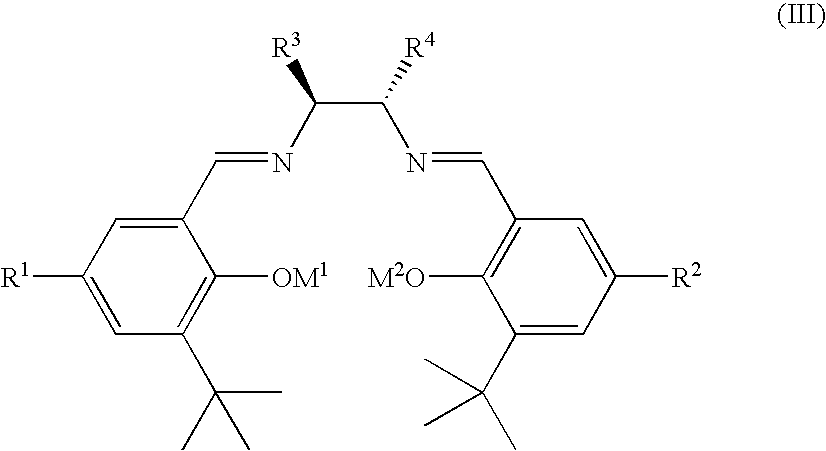Ruthenium(II) catalysts for use in stereoselective cyclopropanations
a cyclopropanation and catalyst technology, applied in the field of##ral catalysts for cyclopropanation, can solve the problems of low yield, low stereoselectivity, and difficult enantiomerization of cyclopropanes, and achieve good stereoselectivity, high yield, and good stereoselectivity
- Summary
- Abstract
- Description
- Claims
- Application Information
AI Technical Summary
Benefits of technology
Problems solved by technology
Method used
Image
Examples
example 1
Ru / Salen / Cylcohexene Catalyst
[0142]In a 50-mL 3-neck neck round bottom flask fitted with a temperature probe, nitrogen inlet, magnetic stir bar and a septum was added (1R,2R)-(−)-1,2-cyclohexanediamino-N,N′-bis-(3,5-di-t-butylsalicylidene) (salen; 2.17 g, 4 mmol) and 25 mL of anhydrous THF. The resultant solution was cooled to 0-5° C. Lithium diisopropylamide(tetrahydrofuran) (1.5 M solution in cyclohexane; 5.3 mL, 8 mmol) was added slowly at a rate that the reaction temperature was kept below 5° C. The solution was stirred for 1 hour at 0-5° C.
[0143]In a 250-mL round bottom flask was charged dichloro(p-cymene)ruthenium(II) dimer (1.21 g, 2 mmol), cyclohexene (0.92 g, 11.2 mmol) and anhydrous THF (60 mL). The mixture was stirred. The salen solution was added in one portion to the stirred suspension at ambient temperature. The salen reaction flask was rinsed with 10 mL of THF and the rinse solution was transferred to the 250-mL flask. The resultant mixture was stirred overnight. The ...
example 2
One Pot Procedure for Ru / Salen / Cylcohexene Catalyst
[0144]In a 50-mL round bottom flask fitted with a temperature probe, nitrogen inlet, magnetic stir bar and a septum was added (1R,2R)-(−)-1,2-cyclohexanediamino-N,N′-bis-(3,5-di-t-butylsalicylidene) (salen, 540 mg, 1 mmol) and 23.5 mL of anhydrous THF. The resulting solution was cooled to 0-5° C. To this was added LDA (1.5 M in cyclohexane, 1.34 mL, 2 mmol) at a rate that allowed the reaction temperature to be maintained below 5° C. The reaction mixture was stirred for 0.5 hour at 0-5° C. To this was added dichloro(p-cymene)ruthenium (II) dimer (300 mg, 0.5 mmol), followed by VBF (0.4 g, 2.8 mmol). After the addition, the mixture was stirred at ambient temperature. The catalyst solution can be used without further work-up in the cyclopropanation reaction as described below. Alternatively, the solution can be concentrated to dryness to provide a green solid that can be used in the cyclopropanation reaction.
example 3
Ru / Salen / 1-hexene Catalyst
[0145]The Ru / salen / 1-hexene catalyst was prepared according to the procedure for Ru / salen / cyclohexene except that 1-hexene was used in place of cyclohexene. The resulting catalyst solution was found to be active in the cyclopropanation reaction of 4-vinyl-2,3-dihydrobenzofuran with ethyl diazoacetate.
PUM
| Property | Measurement | Unit |
|---|---|---|
| enantiomeric excess | aaaaa | aaaaa |
| atomic numbers | aaaaa | aaaaa |
| temperature | aaaaa | aaaaa |
Abstract
Description
Claims
Application Information
 Login to View More
Login to View More - R&D
- Intellectual Property
- Life Sciences
- Materials
- Tech Scout
- Unparalleled Data Quality
- Higher Quality Content
- 60% Fewer Hallucinations
Browse by: Latest US Patents, China's latest patents, Technical Efficacy Thesaurus, Application Domain, Technology Topic, Popular Technical Reports.
© 2025 PatSnap. All rights reserved.Legal|Privacy policy|Modern Slavery Act Transparency Statement|Sitemap|About US| Contact US: help@patsnap.com



